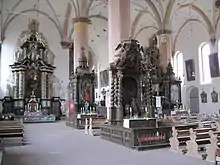Lamspringe Abbey
Lamspringe Abbey (Stift Lamspringe, later Kloster Lamspringe) is a former religious house of the English Benedictines in exile, at Lamspringe near Hildesheim in Germany.
 | |
 Location within Lower Saxony | |
| Monastery information | |
|---|---|
| Full name | Lamspringe Abbey |
| Order | Canonesses Regular; Benedictine |
| Established | 847; 1630 |
| Dedicated to | St Adrian of Corinth & St. Denis |
| Controlled churches | Lamspringe Abbey |
| Site | |
| Location | Lamspringe, Hildesheim, Germany |
| Coordinates | 51.95°N 10°E |
| Other information | The relics of St Oliver Plunkett and the head of St Thomas of Hereford. |
First foundation
The foundation by Count Ricdag of the first religious house at Lamspringe for canonesses is conventionally dated at 847. This Augustinian priory became Lutheran during the Reformation and was destroyed during the Thirty Years' War in 1626.
Second foundation

In 1628 English Benedictine monks in exile approached the Bursfelde Congregation with a request for premises and in 1630 were granted the derelict buildings at Lamspringe, although they were unable to take possession and begin work on the monastery until the early 1640s, after the end of the Thirty Years' War. The English Benedictines rebuilt the abbey, dedicated to St Adrian of Corinth, a 3rd-century martyr, and St. Denis, and from 1671 ran a school here for English Catholic boys, mostly from Yorkshire and the north, which became a centre for Catholic education for, and influence on, Great Britain.
Unlike the other English monasteries in exile, Lamspringe was a large abbey rather than a small priory, and was wealthy, with wide estates, and the community's wealth and status were reflected in the quality of the building works undertaken. The abbey church, serious work on which began in 1691 under abbot Maurus Corker, and the remaining monastery buildings, executed in rather grand style by abbot Joseph Rokeby up to 1731, still remain virtually intact.
Lamspringe Abbey housed the relics of St Oliver Plunkett, taken there in 1684 by the later Abbot of Lamspringe, Corker, who had been with him in prison in London,[1] as well as the head of St Thomas of Hereford.
The abbey was secularised in 1803 by the Kingdom of Prussia, and the monks returned to England. The library was dispersed; it had contained as its most famous item the St. Albans Psalter.
The school was transferred to the then newly established Ampleforth Abbey and formed the basis of the present Ampleforth College.
The monks, after a period of dispersal, reformed as a community at Broadway in Worcestershire between 1828 and 1841, after which they were spread among other houses, although the community was never formally disbanded. The last surviving members joined the abbey at Fort Augustus (1876-1998) at its foundation.
Buildings
The church still serves as the parish church, and the still impressive monastic buildings are put to a variety of parish and community uses. The abbey garden also survives and is one of the attractions of Lamspringe.
Abbots
- Clement Reyner 1645-
- Maurus Corker 1690-95
- Joseph Rokeby 1730-61
- Maurus Heatley 1761-1802
Notes
- the relics are now in Downside Abbey
Sources
| Wikimedia Commons has media related to Lamspringe Abbey. |
- (in German) Lamspringe Municipality official website: History
- Douai Magazine No 166 - 2003: article on Lamspringe Abbey
- Cramer, A., OSB (ed.), 2004. Lamspringe: an English Abbey in Germany 1643-1803. Saint Laurence Papers VII, Ampleforth.